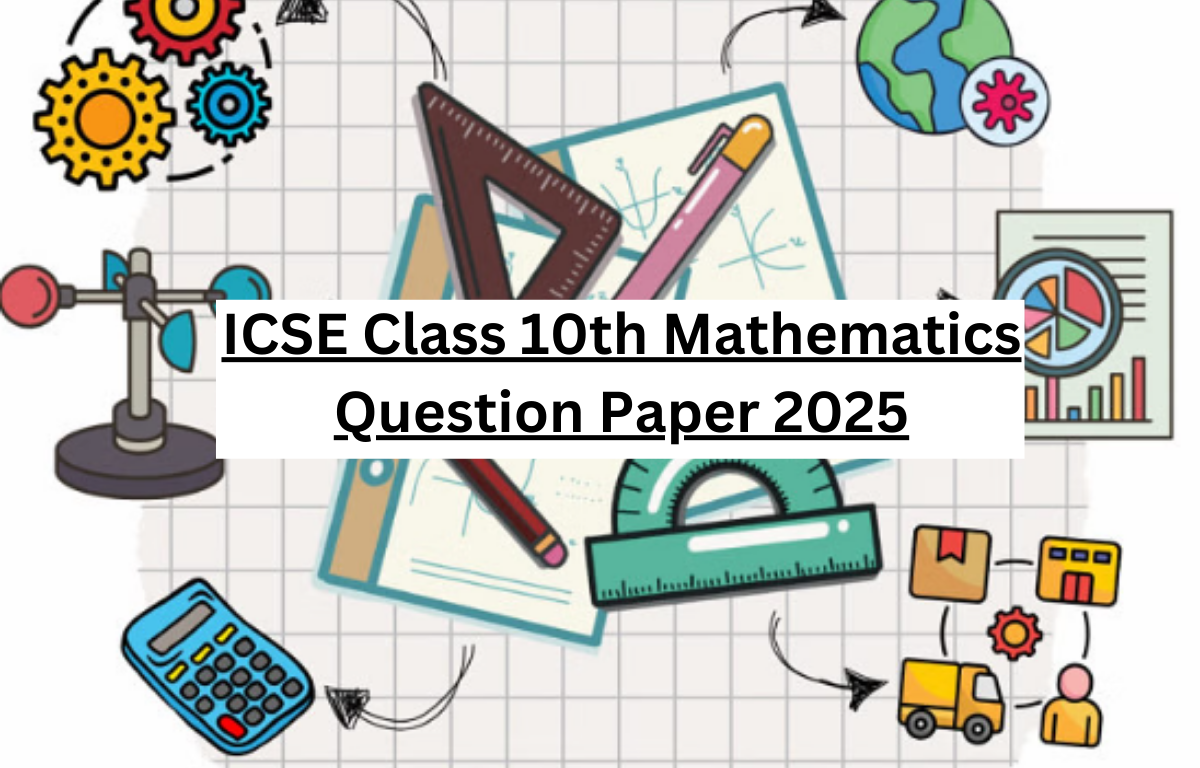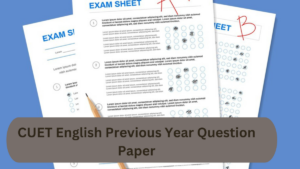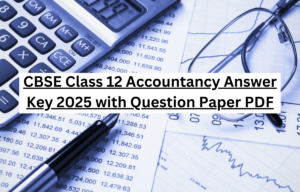Table of Contents
The Council for the Indian School Certificate Examinations (CISCE) successfully conducted the ICSE Class 10 Maths Exam 2025 today, i.e., March 04, 2025 [Tuesday]. As the exam has been successfully held, we will soon share a direct link to download the set-wise ICSE Class 10th Mathematics Question Paper 2025 in the article below. Till then, students are advised to practice their previous year’s question paper along with sample papers, to get a better idea of the exam pattern, marking scheme, and important topics. Students must check out this list of Most Expected Questions for the ICSE Class 10th Maths Exam 2025 in the article below and make their revision sessions more effective.
ICSE Class 10th Mathematics Question Paper 2025
On March 04, 2025 the ICSE Class 10th Mathematics exam 2025 was conducted in the traditional offline mode using pen and paper at various exam centers allocated by the Council for the Indian School Certificate Examinations (CISCE).
The ICSE Class 10 Mathematics Question Paper 2025 was held for a total of 80 marks, with 20 marks for internal assessments. The exam duration was 2 hours, and an extra 15 minutes were given to read the question paper and complete other formalities. Students will be facing a diverse range of questions in the exam that cover various topics. The ICSE Class 10th Maths Question Papers are designed to assess the student’s understanding and application of mathematical concepts.
| ICSE Class 10th Mathematics Question Paper 2025 | |
| Conducting Body | Council for the Indian School Certificate Examinations (CISCE) |
| Name of Examination | ICSE Class 10th Mathematics Exam 2025 |
| Category | Question Paper |
| Status | To be released |
| ICSE Class 10th Maths Exam Date 2025 | March 04, 2025 |
| ICSE Class 10th Mathematics Question Paper 2025 | March 04, 2025 |
| Exam timing | 11:00 am to 2:15 pm |
| Mode of Examination | Offline pen and paper mode |
| Total Marks | 100 marks |
ICSE Class 10th Mathematics Exam Pattern
The ICSE Class 10 Maths exam has different types of questions to check students’ understanding and problem-solving skills. The paper has sections with some must-answer questions and some optional ones. To do well, students should practice daily, review key topics, and use their time wisely in the exam. Solving past years’ papers and sample questions can help them get better at answering quickly and correctly. Regular practice makes it easier to understand concepts and solve problems faster, improving overall performance in the exam.
| ICSE Class 10th Mathematics Exam Pattern | ||
| Section | Type of Questions | Marks |
| Section A | Short Answer Questions like Multiple choice, one-word answers, fill in the blanks, short problems requiring calculations, simple applications of formulas. | 40 Marks |
| Section B | Long Answer Questions | 40 Marks |
| Total Marks | 80 Marks | |
ICSE Class 10th Mathematics Question Paper 2025 PDF Download
As the ICSE Class 10 Mathematics exam is successfully completed, we will soon share the set-wise question papers in PDF format. The direct links for downloading the ICSE 10th Mathematics Question Paper 2025 (Set 1, 2, and 3) will be made available in the table shared below. These papers are valuable for students both before and after the test. Prior to the exam, past question papers help in understanding the exam format, and key points. The ICSE Class 10 Mathematics Question Paper 2025 along with the answer key will help them review their answers and estimate their scores.
- SET A – Question Paper
- SET B – Question Paper
- SET C – Question Paper
- SET D – Question Paper
ICSE Class 10th Mathematics Important Questions with Solutions
Question 1: Find the minimum length in cm and correct it to the nearest whole number of a thin metal sheet required to make a hollow and closed cylindrical box of diameter 20 cm and height 35 cm. The width of the metal sheet is 1 m. Also, find the cost of the sheet at the rate of Rs. 56 per m. Find the area of the metal sheet required if 10% of it is wasted in cutting, overlapping etc.
Solution:
Given,
Diameter of hollow and closed cylinder = 20 cm
Radius of the cylinder = r = 20/2 = 10 cm
Height of cylinder = h = 35 cm
Total surface area of the cylinder = 2πr(r + h)
= 2 × (22/7) × 10 × (10 + 35)
= (44/7) × 10 × 45
= 2828.57 cm2
= 0.282 m2
Width of the sheet = 1 m
Cost of sheet per m = Rs. 56
Total cost of the sheet = 0.282 × Rs. 56 = Rs. 15.8
Length of the sheet = Area of sheet/ Width of the sheet
= 0.282/ 1 = 0.282 m = 28.2 cm
Area of the metal sheet required if 10% of it is wasted in cutting, overlapping etc.,
= 2828.57 + 10% of 2828.57
= 2828.37 + 282.8
= 3111.57 cm2
Question 2: Geetha repays her total loan of 1,18,000 by paying instalments every month. If the instalment for the first month is 1,000 and it increases by 100 every month, what amount will she pay as the 30th instalment of the loan? What amount of the loan has she to still pay after the 30th instalment?
Solution:
Given,
Total loan amount = Rs. 1,18,000
First instalment = Rs. 1000
Second instalment = Rs. 1000 + Rs. 100 = Rs. 1100
Third instalment = Rs. 1100 + Rs. 100 = Rs. 1200
This is an AP with a = 1000 and d = 100
nth term of an Ap:
an = a + (n – 1)d
a30 = 1000 + (30 – 1) × 100
= 1000 + 29 × 100
= 1000 + 2900
= 3900
Therefore, the amount paid in the 30th instalment is Rs. 3900.
Sum of first n term of an AP:
Sn = n/2 [a + an]
S30 = (30/2) × (1000 + 3900)
= 15 × 4900
= 73500
Therefore, the amount paid in 30 instalments is Rs. 73,500
Loan amount to be paid after 30th instalment = Total loan amount – Amount paid in 30 instalments
= Rs. 1,18,000 – Rs. 73,500
= Rs. 44,500
Question 3: Ben deposits a certain sum of money each month in a recurring deposit account of a bank. If the rate of interest is 8% per annum and Ben gets Rs. 8,088 from the bank after 3 years, find the value of his monthly instalment.
Solution:
Let P be the monthly instalment.
Given,
Rate of interest = r = 8%
Time = n = 36 (i.e. 3 years)
Maturity value at the end of 3 years = Rs. 8088
SI = P × [n(n + 1)/ (2 × 12)] × (r/100)
= P × [36(36 + 1)/ 24] × (8/100)
= P × (3 × 37/ 2) × (2/25)
= P × (3 × 37)/25
= 4.44P
Total amount at the time of maturity = (P × n) + SI
8088 = 36P + 4.44P
8088 = 40.44P
P = 8088/ 40.44
P = 200
Therefore, the monthly instalment is Rs. 200.
Question 4: A bag contains 5 white balls, 6 red balls and 9 green balls. A ball is drawn at random from the bag. Find the probability that the ball drawn is:
(i) a green ball
(ii) a white or a red ball
(iii) neither a green ball nor a white ball
Solution:
Given,
A bag contains 5 white balls, 6 red balls and 9 green balls.
Total number of outcomes = n(S) = 5 + 6 + 9 = 20
(i) Let A be the event of getting a green ball.
Number of outcomes favourable to A = n(A) = 9
P(A) = n(A)/ n(S)
= 9/20
(ii) Let B be the event of getting a white or a red ball.
Number of outcomes favourable to B = n(B) = 11
i.e. 5(white) + 6(red) = 11 balls
P(B) = n(B)/ n(S)
= 11/20
(iii) Let C be the event of getting neither a green ball nor a white ball.
Number of outcomes favourable to C = n(C) = 6
i.e. Total number of balls – (green + white balls) = 20 – (9 + 5) = 6
P(C) = n(C)/ n(S)
= 6/20
= 3/10
Question 7: Prove by factor theorem that
(i) (x – 2) is a factor of 2x3 – x2 – 7x + 2
(ii) (2x + 1) is a factor of 4x3 + 12x2 + 7x +1
(iii) (3x – 2) is a factor of 18x3 – 3x2 + 6x – 8
Solution:
(i) Let p(x) = 2x3 – x2 – 7x + 2
For checking, (x – 2) is a factor of p(x); substitute x = 2 in p(x).
p(2) = 2(2)3 – (2)2 – 7(2) + 2
= 2(8) – 4 – 14 + 2
= 16 – 18 + 2
= 0
Therefore, (x – 2) is a factor of 2x3 – x2 – 7x + 2.
(ii) Let p(x) = 4x3 + 12x2 + 7x +1
For checking, (2x + 1) is a factor of p(x); substitute x = -1/2 in p(x).
p(-½) = 4(-½)3 + 12(-½)2 + 7(-½) + 1
= 4(-⅛) + 12(¼) – (7/2) + 1
= (-½) + 3 – (7/2) + 1
= (-8/2) + 4
= -4 + 4
= 0
Therefore, (2x + 1) is a factor of 4x3 + 12x2 + 7x +1.
(iii) Let p(x) = 18x3 – 3x2 + 6x – 8
For checking, (3x – 2) is a factor of p(x); substitute x = 2/3 in p(x).
p(⅔) = 18(⅔)3 – 3(⅔)2 + 6(⅔) – 12
= 18(8/27) – 3(4/9) + 4 – 8
= (16/3) – (4/3) – 4
= (12/3) – 4
= 4 – 4
= 0








 CUET English Previous Year Question Pape...
CUET English Previous Year Question Pape...
 CBSE Class 12 Accountancy Answer Key 202...
CBSE Class 12 Accountancy Answer Key 202...
 CBSE Class 12th Political Science Questi...
CBSE Class 12th Political Science Questi...







